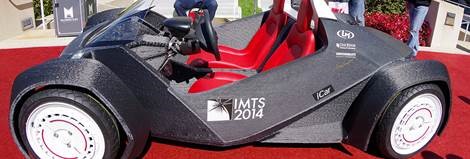3D printing is a buzz word in electronics and the possibilities for its use seem endless, limited by our imagination. We’ve all heard about some of the fantastical uses including simple everyday devices to very sophisticated items such as electronic circuits.
Now, in 2015, we have the Strati, the world's first car with a load-bearing structure and a body being integrally 3D printed. It was developed by US start up Local Motors. In 2014, the company undertook a challenge to build a 3D car live on the internet. In late 2015, the first street legal versions are expected to be delivered to customers.

The Strati is made from 212 layers of ABS plastic reinforced with carbon fiber. The printing process currently takes 44 hours, but the company should get it down to 24 hours. Some of the electrical and electronic parts will be printed into the car as it is built up by the 3D printing process. Components such as the battery, motor and wiring that cannot yet be printed currently come from a Renault Twizy electric microEV. Instead of vehicles manufactured in a huge central factory, Local Motors plans 100 microfactories in the next 10 years. Maybe even from your garage.
IDTechEx , says future models could benefit from the structural supercapacitor bodywork for cars being developed by Imperial College London, Volvo Geely of China, Vanderbilt University in the USA and Queensland University of Technology in Australia. It could use load-bearing supercapacitor printed circuit boards from Cambridge University in the UK and in-mold control and lighting electronics from T-Ink in the USA and others.
No moving parts to go wrong; just weather and impact-proof intelligent structures. Little or no dumb bodywork anymore, whether it is a car, truck, boat or a plane. Many structural electronics capabilities will converge in the lighter, more affordable, more capable vehicle of the future. For example, buses are already losing their “ladder chassis” and becoming “integral” often with in-wheel motors in electric versions, on the way to being complemented with structural electronic bodywork.
See the IDTechEx reports, “Structural Electronics 2015-2025” www.idtechex.com/structural and “Electric Buses 2015-2025” www.idtechex.com/evbuses for more information.
Advertisement





